Abstract
Over a 9-day period in February 1995, 16 newborn babies (age range 2-11 days) and 3 infants (24, 47 and 180 days of age) in a neonatal nursery ward developed diarrhoea accompanied by pyrexia and weight loss. Known enteropathogens were not detected in their stools but Escherichia coli displaying aggregative adherence to HEp-2 cells (enteroaggregative E. coli) were found in 12 (63%) ill infants and in none of 5 well neonates (P = 0.02). The illness lasted 3-9 days (mean 5.2) in 16 babies, whereas in 3 neonates it showed a protracted course of 18-20 days. The source of infection and the mode of transmission remained unclear. The outbreak isolates manifested properties common in this new group of diarrhoeagenic E. coli: mannose-resistant haemagglutination, haemolysis on blood agar, and clump formation in liquid culture medium. They belonged to the O4 E. coli serogroup and expressed multiple antibiotic resistance.
Full text
PDF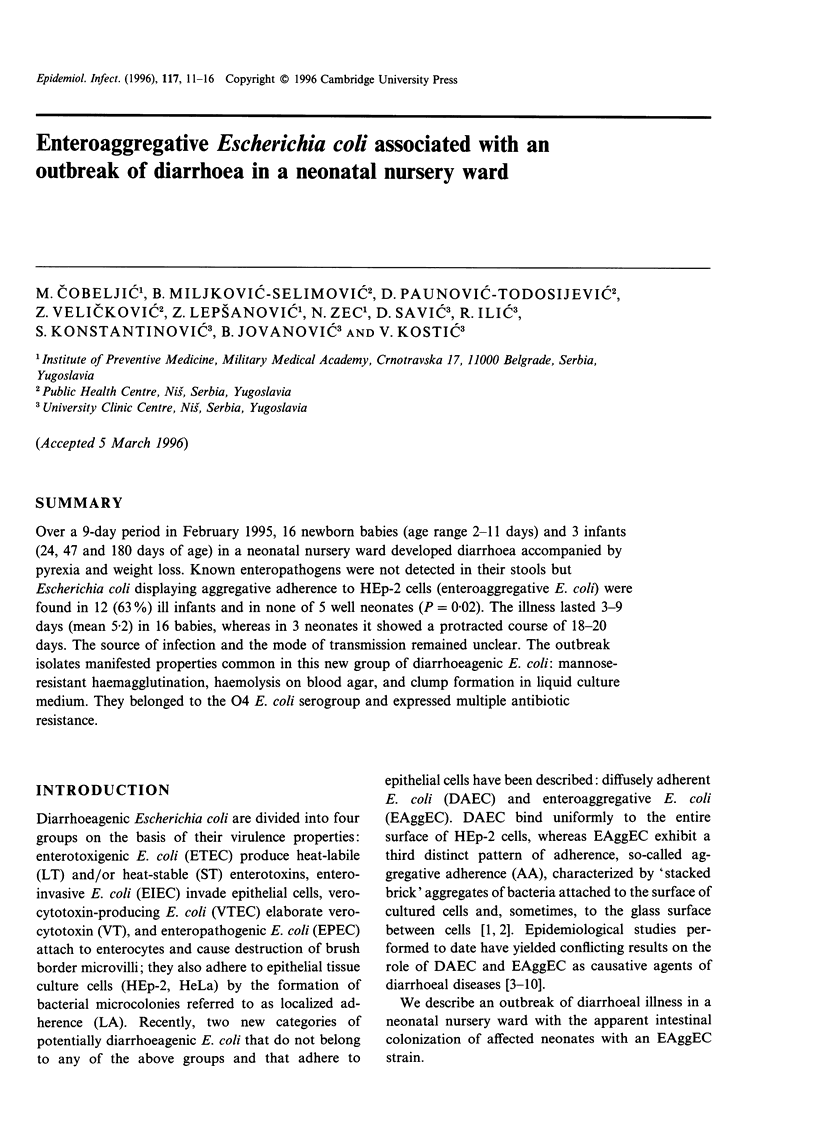
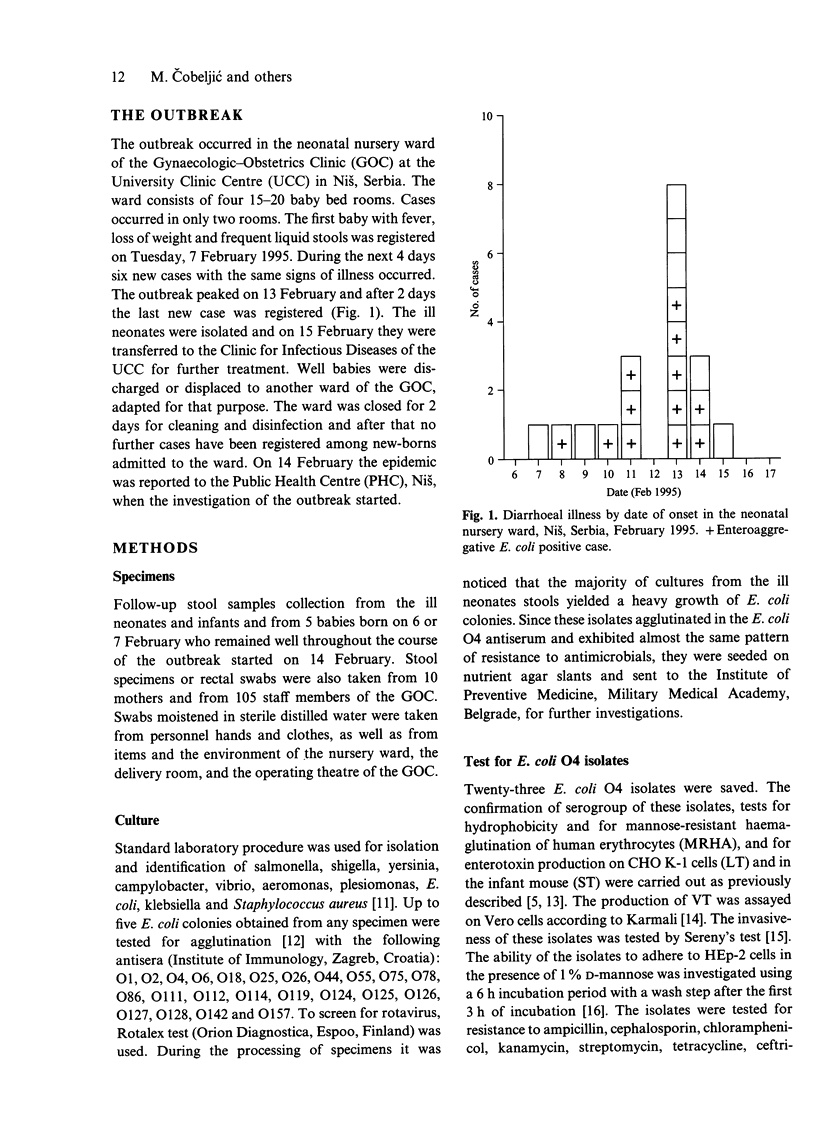
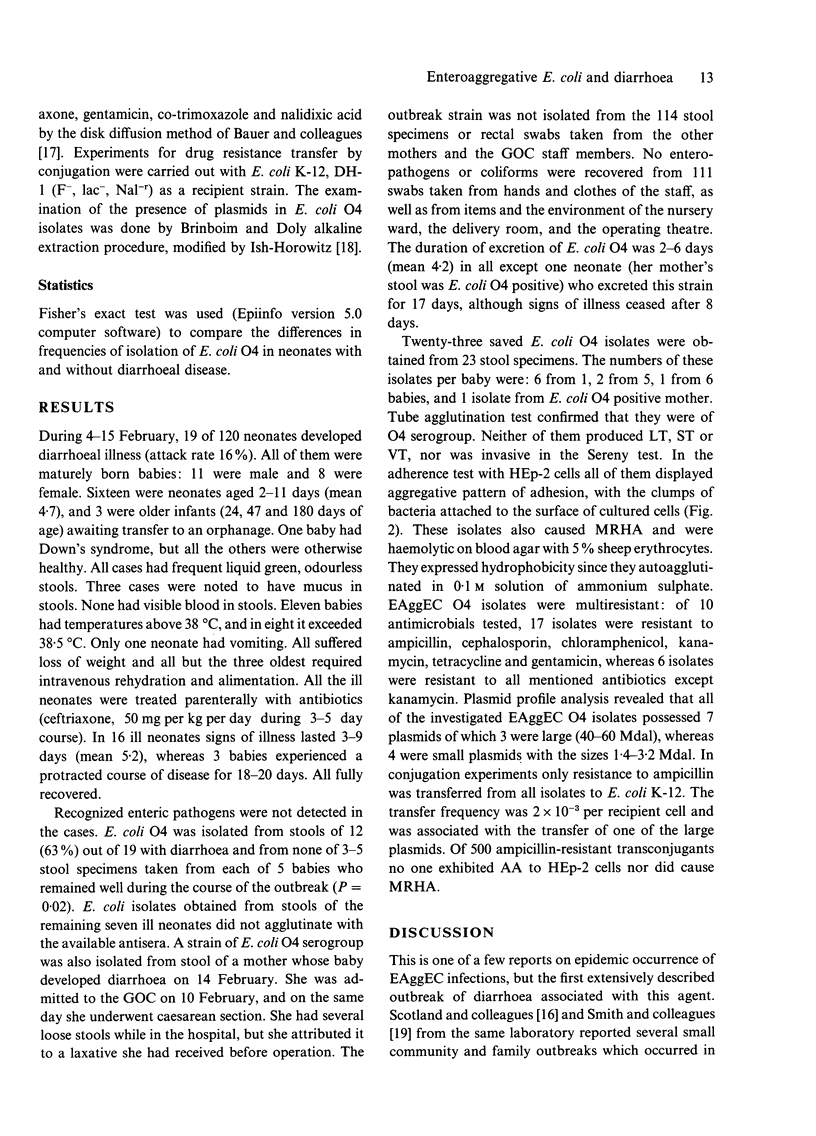
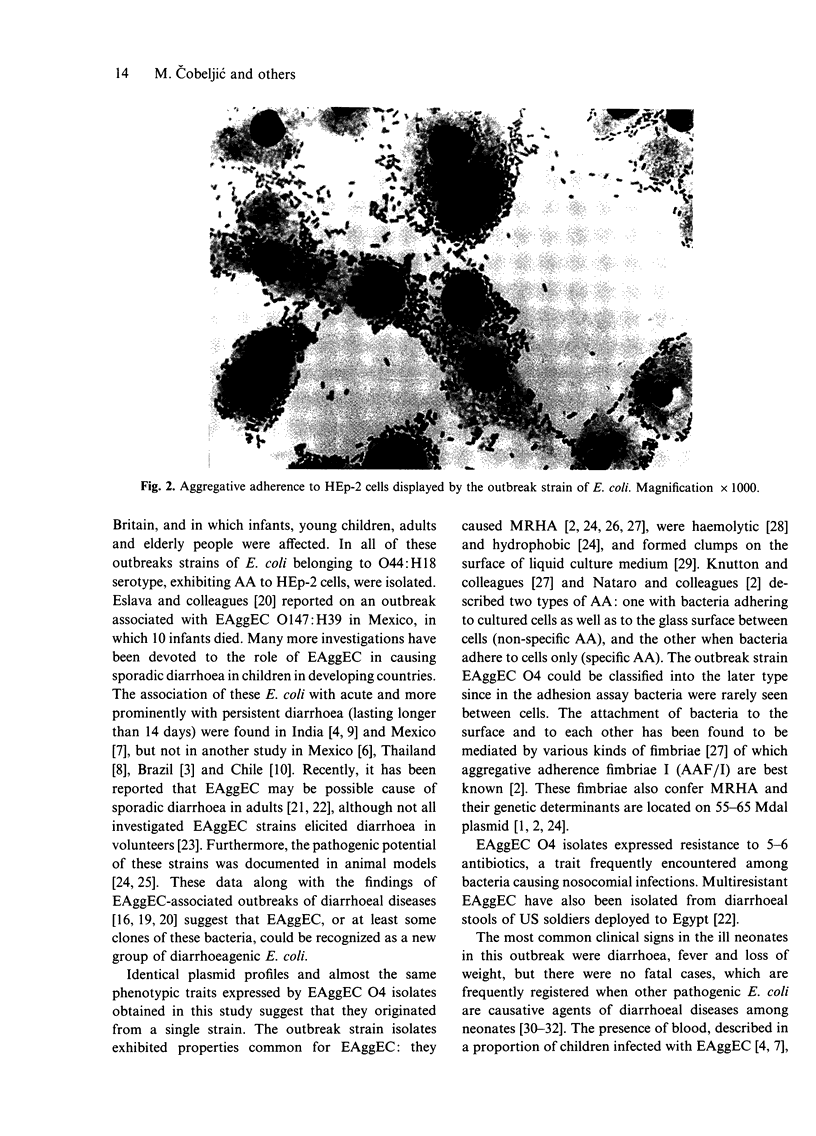
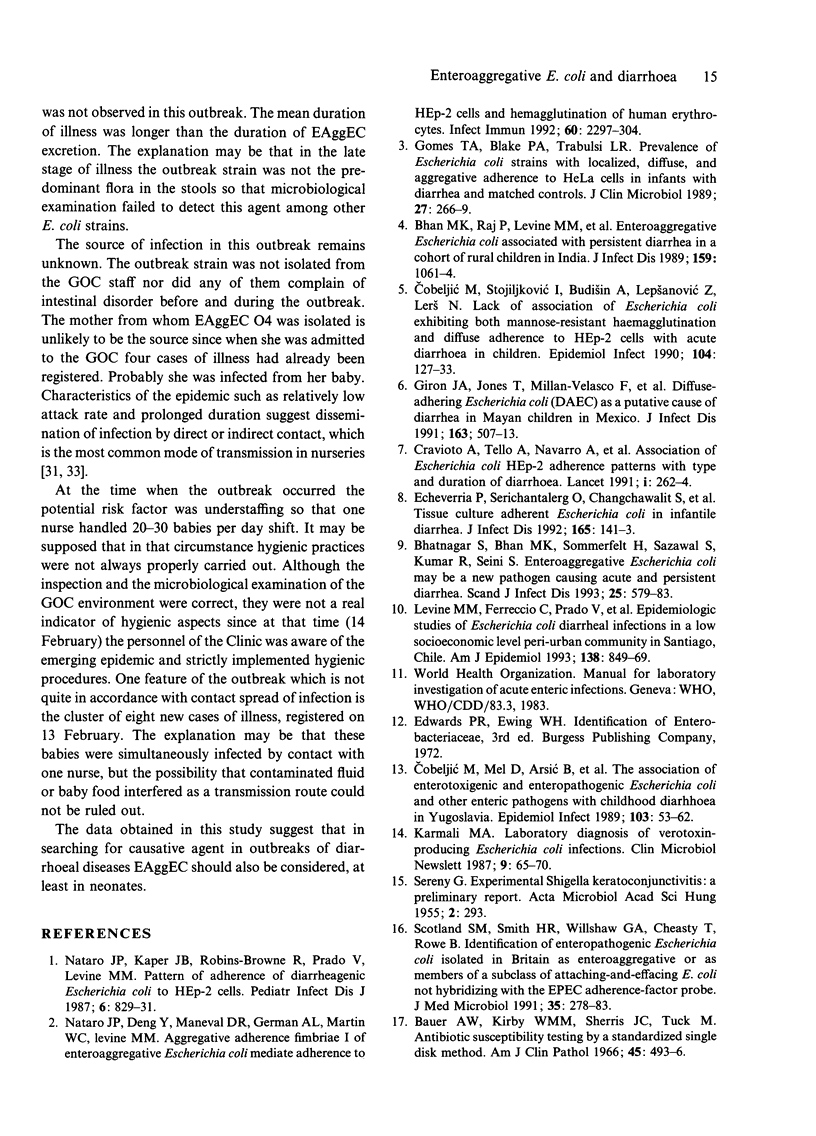
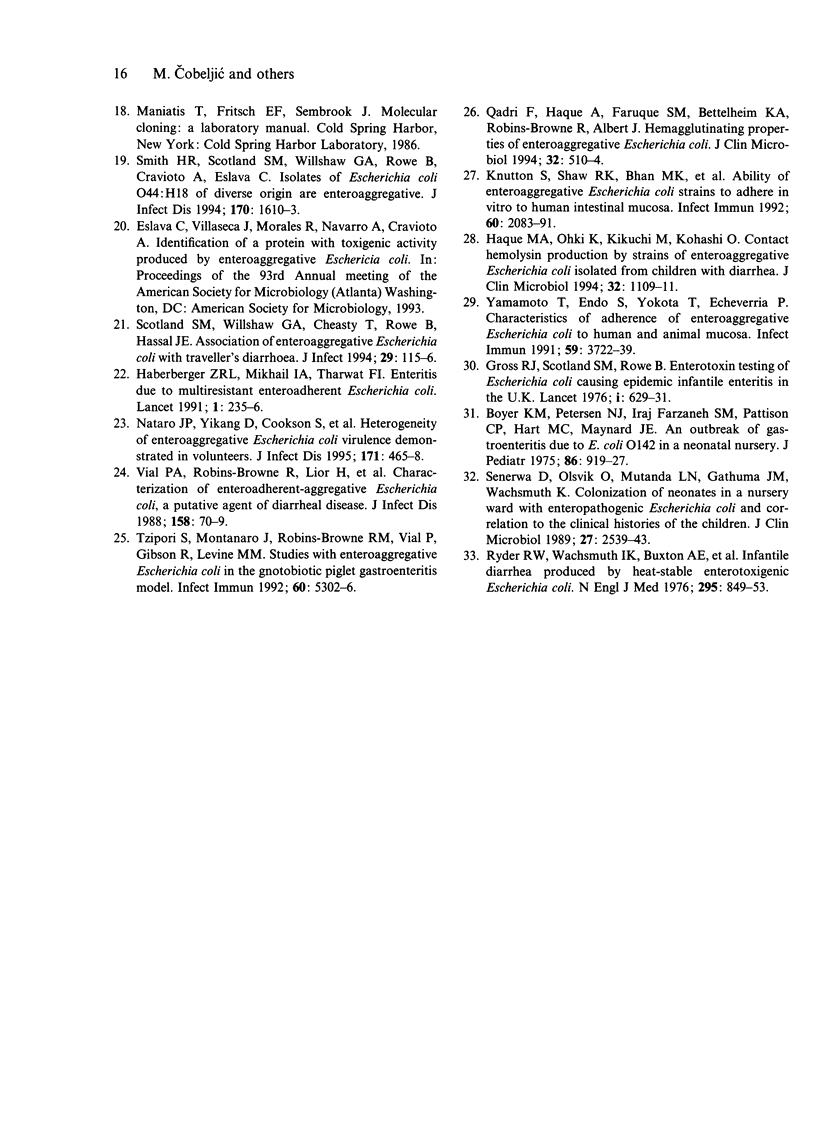
Images in this article
Selected References
These references are in PubMed. This may not be the complete list of references from this article.
- Bauer A. W., Kirby W. M., Sherris J. C., Turck M. Antibiotic susceptibility testing by a standardized single disk method. Am J Clin Pathol. 1966 Apr;45(4):493–496. [PubMed] [Google Scholar]
- Bhan M. K., Raj P., Levine M. M., Kaper J. B., Bhandari N., Srivastava R., Kumar R., Sazawal S. Enteroaggregative Escherichia coli associated with persistent diarrhea in a cohort of rural children in India. J Infect Dis. 1989 Jun;159(6):1061–1064. doi: 10.1093/infdis/159.6.1061. [DOI] [PubMed] [Google Scholar]
- Bhatnagar S., Bhan M. K., Sommerfelt H., Sazawal S., Kumar R., Saini S. Enteroaggregative Escherichia coli may be a new pathogen causing acute and persistent diarrhea. Scand J Infect Dis. 1993;25(5):579–583. doi: 10.3109/00365549309008546. [DOI] [PubMed] [Google Scholar]
- Boyer K. M., Petersen N. J., Farzaneh I., Pattison C. P., Hart M. C., Maynard J. E. An outbreak og gastroenteritis due to E. coli 0142 in a neonatal nursery. J Pediatr. 1975 Jun;86(6):919–927. doi: 10.1016/s0022-3476(75)80230-7. [DOI] [PubMed] [Google Scholar]
- Cobeljić M., Mel D., Arsić B., Krstić L., Sokolovski B., Nikolovski B., Sopovski E., Kulauzov M., Kalenić S. The association of enterotoxigenic and enteropathogenic Escherichia coli and other enteric pathogens with childhood diarrhoea in Yugoslavia. Epidemiol Infect. 1989 Aug;103(1):53–62. doi: 10.1017/s0950268800030351. [DOI] [PMC free article] [PubMed] [Google Scholar]
- Cobeljić M., Stojiljković I., Budisin A., Lepsanović Z., Lers N. Lack of association of Escherichia coli exhibiting both mannose-resistant haemagglutination and diffuse adherence to HEp-2 cells with acute diarrhoea in children. Epidemiol Infect. 1990 Feb;104(1):127–133. doi: 10.1017/s0950268800054601. [DOI] [PMC free article] [PubMed] [Google Scholar]
- Cravioto A., Tello A., Navarro A., Ruiz J., Villafán H., Uribe F., Eslava C. Association of Escherichia coli HEp-2 adherence patterns with type and duration of diarrhoea. Lancet. 1991 Feb 2;337(8736):262–264. doi: 10.1016/0140-6736(91)90868-p. [DOI] [PubMed] [Google Scholar]
- Echeverria P., Serichantalerg O., Changchawalit S., Baudry B., Levine M. M., Orskov F., Orskov I. Tissue culture-adherent Escherichia coli in infantile diarrhea. J Infect Dis. 1992 Jan;165(1):141–143. doi: 10.1093/infdis/165.1.141. [DOI] [PubMed] [Google Scholar]
- Girón J. A., Jones T., Millán-Velasco F., Castro-Muñoz E., Zárate L., Fry J., Frankel G., Moseley S. L., Baudry B., Kaper J. B. Diffuse-adhering Escherichia coli (DAEC) as a putative cause of diarrhea in Mayan children in Mexico. J Infect Dis. 1991 Mar;163(3):507–513. doi: 10.1093/infdis/163.3.507. [DOI] [PubMed] [Google Scholar]
- Gomes T. A., Blake P. A., Trabulsi L. R. Prevalence of Escherichia coli strains with localized, diffuse, and aggregative adherence to HeLa cells in infants with diarrhea and matched controls. J Clin Microbiol. 1989 Feb;27(2):266–269. doi: 10.1128/jcm.27.2.266-269.1989. [DOI] [PMC free article] [PubMed] [Google Scholar]
- Gross R. J., Scotland S. M., Rowe B. Enterotoxin testing of Escherichia coli causing epidemic infantile enteritis in the U.K. Lancet. 1976 Mar 20;1(7960):629–631. doi: 10.1016/s0140-6736(76)90429-3. [DOI] [PubMed] [Google Scholar]
- Haberberger R. L., Jr, Mikhail I. A., Ismail T. F. Enteritis due to multiresistant enteroadherent Escherichia coli. Lancet. 1991 Jan 26;337(8735):235–236. doi: 10.1016/0140-6736(91)92197-a. [DOI] [PubMed] [Google Scholar]
- Haque M. A., Ohki K., Kikuchi M., Kohashi O. Contact hemolysin production by strains of enteroaggregative Escherichia coli isolated from children with diarrhea. J Clin Microbiol. 1994 Apr;32(4):1109–1111. doi: 10.1128/jcm.32.4.1109-1111.1994. [DOI] [PMC free article] [PubMed] [Google Scholar]
- Knutton S., Shaw R. K., Bhan M. K., Smith H. R., McConnell M. M., Cheasty T., Williams P. H., Baldwin T. J. Ability of enteroaggregative Escherichia coli strains to adhere in vitro to human intestinal mucosa. Infect Immun. 1992 May;60(5):2083–2091. doi: 10.1128/iai.60.5.2083-2091.1992. [DOI] [PMC free article] [PubMed] [Google Scholar]
- Levine M. M., Ferreccio C., Prado V., Cayazzo M., Abrego P., Martinez J., Maggi L., Baldini M. M., Martin W., Maneval D. Epidemiologic studies of Escherichia coli diarrheal infections in a low socioeconomic level peri-urban community in Santiago, Chile. Am J Epidemiol. 1993 Nov 15;138(10):849–869. doi: 10.1093/oxfordjournals.aje.a116788. [DOI] [PubMed] [Google Scholar]
- Nataro J. P., Deng Y., Cookson S., Cravioto A., Savarino S. J., Guers L. D., Levine M. M., Tacket C. O. Heterogeneity of enteroaggregative Escherichia coli virulence demonstrated in volunteers. J Infect Dis. 1995 Feb;171(2):465–468. doi: 10.1093/infdis/171.2.465. [DOI] [PubMed] [Google Scholar]
- Nataro J. P., Deng Y., Maneval D. R., German A. L., Martin W. C., Levine M. M. Aggregative adherence fimbriae I of enteroaggregative Escherichia coli mediate adherence to HEp-2 cells and hemagglutination of human erythrocytes. Infect Immun. 1992 Jun;60(6):2297–2304. doi: 10.1128/iai.60.6.2297-2304.1992. [DOI] [PMC free article] [PubMed] [Google Scholar]
- Nataro J. P., Kaper J. B., Robins-Browne R., Prado V., Vial P., Levine M. M. Patterns of adherence of diarrheagenic Escherichia coli to HEp-2 cells. Pediatr Infect Dis J. 1987 Sep;6(9):829–831. doi: 10.1097/00006454-198709000-00008. [DOI] [PubMed] [Google Scholar]
- Qadri F., Haque A., Faruque S. M., Bettelheim K. A., Robins-Browne R., Albert M. J. Hemagglutinating properties of enteroaggregative Escherichia coli. J Clin Microbiol. 1994 Feb;32(2):510–514. doi: 10.1128/jcm.32.2.510-514.1994. [DOI] [PMC free article] [PubMed] [Google Scholar]
- Ryder R. W., Wachsmuth I. K., Buxton A. E., Evans D. G., DuPont H. L., Mason E., Barrett F. F. Infantile diarrhea produced by heat-stable enterotoxigenic Escherichia coli. N Engl J Med. 1976 Oct 14;295(16):849–853. doi: 10.1056/NEJM197610142951601. [DOI] [PubMed] [Google Scholar]
- SERENY B. Experimental shigella keratoconjunctivitis; a preliminary report. Acta Microbiol Acad Sci Hung. 1955;2(3):293–296. [PubMed] [Google Scholar]
- Scotland S. M., Smith H. R., Said B., Willshaw G. A., Cheasty T., Rowe B. Identification of enteropathogenic Escherichia coli isolated in Britain as enteroaggregative or as members of a subclass of attaching-and-effacing E. coli not hybridising with the EPEC adherence-factor probe. J Med Microbiol. 1991 Nov;35(5):278–283. doi: 10.1099/00222615-35-5-278. [DOI] [PubMed] [Google Scholar]
- Scotland S. M., Willshaw G. A., Cheasty T., Rowe B., Hassall J. E. Association of enteroaggregative Escherichia coli with travellers' diarrhoea. J Infect. 1994 Jul;29(1):115–116. doi: 10.1016/s0163-4453(94)95465-8. [DOI] [PubMed] [Google Scholar]
- Senerwa D., Olsvik O., Mutanda L. N., Gathuma J. M., Wachsmuth K. Colonization of neonates in a nursery ward with enteropathogenic Escherichia coli and correlation to the clinical histories of the children. J Clin Microbiol. 1989 Nov;27(11):2539–2543. doi: 10.1128/jcm.27.11.2539-2543.1989. [DOI] [PMC free article] [PubMed] [Google Scholar]
- Smith H. R., Scotland S. M., Willshaw G. A., Rowe B., Cravioto A., Eslava C. Isolates of Escherichia coli O44:H18 of diverse origin are enteroaggregative. J Infect Dis. 1994 Dec;170(6):1610–1613. doi: 10.1093/infdis/170.6.1610. [DOI] [PubMed] [Google Scholar]
- Tzipori S., Montanaro J., Robins-Browne R. M., Vial P., Gibson R., Levine M. M. Studies with enteroaggregative Escherichia coli in the gnotobiotic piglet gastroenteritis model. Infect Immun. 1992 Dec;60(12):5302–5306. doi: 10.1128/iai.60.12.5302-5306.1992. [DOI] [PMC free article] [PubMed] [Google Scholar]
- Vial P. A., Robins-Browne R., Lior H., Prado V., Kaper J. B., Nataro J. P., Maneval D., Elsayed A., Levine M. M. Characterization of enteroadherent-aggregative Escherichia coli, a putative agent of diarrheal disease. J Infect Dis. 1988 Jul;158(1):70–79. doi: 10.1093/infdis/158.1.70. [DOI] [PubMed] [Google Scholar]
- Yamamoto T., Endo S., Yokota T., Echeverria P. Characteristics of adherence of enteroaggregative Escherichia coli to human and animal mucosa. Infect Immun. 1991 Oct;59(10):3722–3739. doi: 10.1128/iai.59.10.3722-3739.1991. [DOI] [PMC free article] [PubMed] [Google Scholar]



